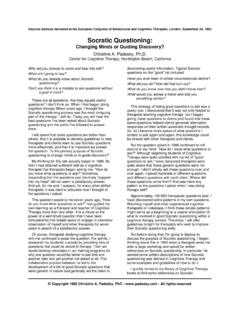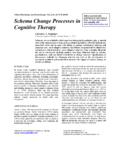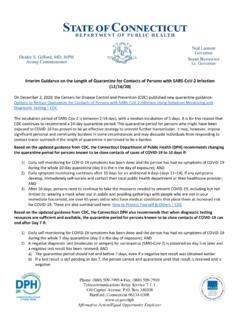Transcription of Clinical Psychology and Psychotherapy Article reprinted ...
1 Article reprinted withpermission of John Wiley &Sons. To learn more abouttheir journals, Psychology and Psychotherapy , Vol. 1 (5), 267-278 (1994) schema Change Processes inCognitive TherapyChristine A. Padesky*Center for Cognitive Therapy, Newport Beach, CA, USAS chemas are core beliefs which cognitive therapists hypothesize play a centralrole in the maintenance of long-term psychiatric problems. Clinical methods aredescribed which can be used with clients to weaken maladaptive schemas andconstruct new, more adaptive schemas. guidelines are presented for identifyingmaladaptive and alternative, more adaptive schemas. Case examples illustratethe use of continuum methods, positive data logs, historical tests of schema ,psychodrama, and core belief worksheets to change schemas. Specification oftherapeutic methods for changing schemas can lead to the development oftreatment standards and protocols to measure the impact of schema change onchronic recent years, cognitive therapists have devotedincreased attention to schemas, core beliefs which arehypothesized to play a key role in the maintenance oflong-term psychiatric problems including personalitydisorders, chronic depression, chronic anxiety disorders,and chronic relationship difficulties.
2 Case descriptionsof treatment outcome with these disorders often creditpositive results to changing maladaptive core schemasand building alternative, more adaptive schemas (Becket al., 1990). However, there are few detaileddescriptions in the literature of the Clinical processesused to accomplish schema change. This paper describesschema change processes in detail with OF SCHEMAA aron T. Beck, MD introduced the concept of schemasto cognitive therapy. Beck's first book (1967) creditsPiaget (1948) with the origin of the word schema todescribe cognitive structures. Summarizing Harvey et al.(1961), Beck added his own definition that 'a schema isa structure for screening, coding, and evaluating thestimuli that impinge onthe organism. It is the mode by which the environment isbroken down and organized into its many psychologicallyrelevant facets.
3 On the basis of schemas, the individual isable to .. categorize and interpret his experiences in ameaningful way' (p. 283).This early definition was echoed in later works whichdefined schemas as 'stable cognitive patterns' whichprovide a 'basis for screening out differentiating, andcoding the stimuli that confront the individual' (Beck et , ) and as 'specific rules that governinformation processing and behavior' (Beck et a1., 1990, ). In this latter book, the authors differentiate betweencore beliefs such as 'I'm no good' and conditional beliefssuch as 'If people got close to me, they would discover the"real me" and would reject me' (p. 43). Both core andconditional beliefs are referred to as 'schemas' in their this paper 'schemas' will be used only to describe corebeliefs. For Clinical purposes, this author finds it useful todifferentiate between schemas (core beliefs), underlyingassumptions (conditional beliefs), and automatic thoughts(cognitions that automatically and temporarily flowthrough one's mind).
4 Theoretically, core beliefs andconditional beliefs are similar in that they are both deepercognitive structures than automatic thoughts. However,different therapeutic processes are used to evaluate andchange these two types of beliefs. Conditional_____*Address for correspondence: Christine A. PadeskyWebsite CCC1063-3995/94/050267-12 1994 by John Wiley & Sons, by permission of John Wiley & Sons, A. Padeskybeliefs are often best tested through the use ofbehavioural experiments. Core beliefs are best suited tothe evaluation methods described AND MAINTENANCE OFSCHEMASC ognitive therapy is based on an information processingtheory which posits that schemas develop as part ofnormal cognitive development. According to informationprocessing theory, we group experiences into categoriesto help us understand and organize our world. A childgroups dogs, cats, and lions as 'animals' and may have amore specific schema of 'pet' that includes the first twoanimals but not the schemas that are of greatest interest in therapy arethose closely related to affective states or behaviouralpatterns.
5 Each person has self schemas as well asschemas about others and the world that affect emotionaland behavioural reactions. Schemas do not necessarilycause chronic emotional or behavioural , schemas seem to play a central role in themaintenance of chronic problems regardless of theaetiological roots of these example, one person may have experienced lifelongdepression due to a variety of factors including a strongpositive loading for depression and serious life stressesand strains ( childhood abuse, familial deaths, andmultiple failure experiences). Along the way, this personis likely to have developed negative schemas such as 'I'mno good' (self), 'Others can't be trusted' (others) and'effort does not pay off' (world).To overcome depression, it may be necessary for thisperson to make behavioural and cognitive changes. Evenif environmental stressors and heredity are assumed toplay a primary role in the development of this depression,key therapeutic steps are unlikely to be attempted andmaintained by this person unless the schemas areevaluated and modified.
6 This person's world- schema willerode motivation to attempt change, the self- schema mayinterfere with recognition of therapy progress, and theschema regarding others may lead to difficulties in thetherapy relationship and in relationships with family andfriends who might otherwise support serve a powerful maintenance function forproblems because schemas determine what we notice,attend to, and remember of our experiences(Hastie, 1981; Marcus and Zajonc, 1985; Miller andTurnbull, 1986). A person who believes 'effort does notpay off' will notice and remember failure experiencesmore readily than success experiences. Someone with aself- schema , 'I am bad', will focus on personal defects,flaws, and errors, noticing and remembering these morethan strengths, positive gains, and successes. Onceformed, schemas are maintained in the face ofcontradictory evidence through the processes ofdistorting, not noticing, and discounting contradictoryinformation or by seeing this information as anexception to the schematic, and therefore 'normative',rule (Hastie, 1981; Bodenhausen, 1988; Beck etal.)
7 ,1990).The ease with which schemas are maintained even in theface of contradictory evidence poses a dilemma forcognitive therapists. Much of cognitive therapy relies onmodifying beliefs through the review or production ofevidence that contradicts negative or maladaptiveconclusions drawn by a client. With problems of relativeshort duration (several months for a child or severalyears for an adult), production of contradictory evidenceoften leads to a shift in belief. This shift in belief canoccur quickly (within a therapeutic hour or over thecourse of several weeks) if supporting alternativeschemas exist. That is, a depressed person who currentlyhas an 'I am bad' self- schema activated may be able toshift this belief within a few weeks if this person has an'I'm OK' schema which is normally activated in the non-depressed , people with lifelong or chronic problemsoften do not have an alternative schema available, andtherefore, no amount of contradictory evidence will shifttheir beliefs.
8 A person whose only self- schema over thecourse of a lifetime has been 'I am bad' will look at a listof data supporting an 'I'm OK' conclusion and say to thetherapist, 'Yes, I see this evidence, but I am still bad'.For this reason, treatment of chronic problems withincognitive therapy usually involves not only testingmaladaptive beliefs but also identifying andstrengthening alternative, more adaptive schemas. Analternative schema must be developed before the clientwill be capable of looking at the evidence and saying,'Yes, this suggests I might be OK'. The remainder of thisarticle will focus on Clinical methods that seem helpfulin accomplishing the dual goals of weakeningmaladaptive schemas and developing more Change Processes269 IDENTIFYING MALADAPTIVE SCHEMASBeck (1967) postulated that schemas and affect areclosely joined ( ).
9 For this reason, a therapistwishing to identify maladaptive schemas should followthe affect. A client who is feeling intensely depressed,anxious, angry, guilty or ashamed can be asked, 'Whatdoes this [internal or external event] say about you?' toaccess self-schemas, 'What does this say about otherpeople?' to access other-schemas, and What does this sayabout your life or how the world operates?' to is important to identify all three types of schemasbecause they will interact with each other to help explaina person's affect, behaviour, and motivations. Forexample, two people may have self-schemas, 'I'minadequate'. The first may have an other- schema , 'Othersare critical', and, therefore, adopt avoidant behaviouralstrategies and withdraw from challenging situations. Thesecond person may have an other- schema , 'Others areprotective', and adopt dependent interpersonal strategiesand be willing to enter any situation if accompanied by ahelpful questioning the meaning of high affect events willusually quickly lead to the identification of schemas,other methods can also be employed.
10 Clients can berequested to do a simple series of sentence completions, 'Iam _____', 'People are _____' and 'Theworld is _____'. Since schemas are usuallystated as absolutes, these sentences can usually becompleted with a single word to identify a questionnaires can also be used as a starting pointto identify core beliefs. These include the DysfunctionalAttitude Scale (Weissman and Beck, 1978; Weissman,1979), the schema checklist in Appendix A of the text onpersonality disorders written by Beck and colleagues(Beck et al., 1990), and the schema questionnairedeveloped by Young (Young, 1990). Thesequestionnaires include a variety of core and conditionalbeliefs and clients can be expected to endorse many ofthe beliefs listed. For these reasons, these questionnairesare helpful for broadly conceptualizing a client's beliefsystem. Further discussion with the client will benecessary to determine which of the many beliefsendorsed are most strongly held and central to theproblem of focus in a therapist and client have identified core schemas,it is important that these be expressed in the client'spersonal language and idiom.








